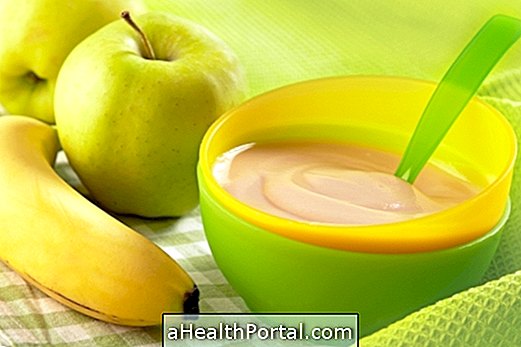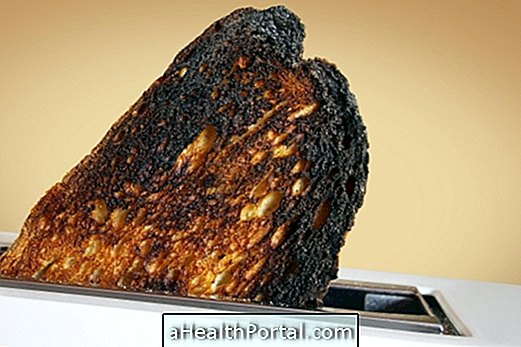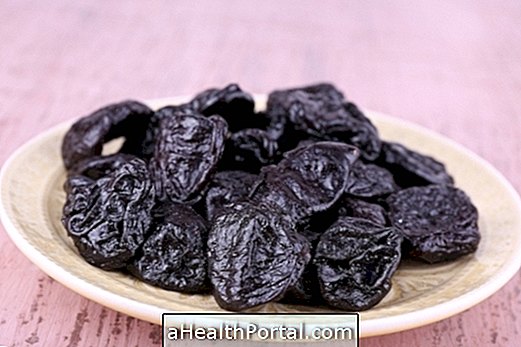In the feeding of the baby at 6 months, the introduction of new foods should begin on the menu, interspersed with the feedings or with the use of milk formula suitable for the age. So it is at this stage that foods such as vegetables, fruits and porridges should be added in the diet, always with the consistency of purees to facilitate swallowing and digestion.
During the introduction of new foods into the baby's menu, it is important that each new food is introduced on its own, to facilitate the identification of allergies or food sensitivities, allowing the family to know the reasons for problems such as stomach pain, diarrhea or arrest. belly Ideally, a new food should be introduced into the diet every 3 days, which also makes it easier for the baby to adapt to the taste and texture of new foods.
Meet the BLW method of introducing food, where the baby begins to eat alone with his hands, only cooked food at all meals.

So, the ideal is to start with the following foods:
- Soups or vegetable purees: are rich in vitamins, minerals and fiber that are essential for the correct development of the baby. Some examples of vegetables that can be given are pumpkin, potato, carrot, sweet potato, zucchini, cauliflower, chuchu and onion. In addition, the soup or puree should be made without using salt, adding 1 teaspoon of olive oil after the preparation is ready.
- Fruit purée: shaved or crushed fruits should be given to the baby in the morning or afternoon snacks, and you can also offer cooked fruits, but always without adding sugar. Some good fruits to start baby's solid nutrition are apple, pear, banana and papaya.
- Mingaus: Mingaus should be done according to the advice of the pediatrician or nutritionist, following the dilution indicated on the label. Cereals, flours and starch mingaps can be given using sources such as corn, rice, wheat and cassava. In addition, you should not avoid giving your baby gluten, as contact with gluten decreases the chances of food intolerance in the future.
It is natural that in the first solid meals the baby eats very little, as he is still developing the ability to swallow food and dwelling on new flavors and textures. Thus, it is usually necessary to supplement the meal with breast milk or bottle, being important not to force the baby to eat more than he wishes.
Food routine
An example of a 6-month-old baby's eating routine during a day may be:
- Breakfast (7 am): Breast milk or bottle;
- Morning snack (10 am): Fruit puree with banana and apple;
- Lunch (13h): Vegetable puree with sweet potatoes, pumpkin and cauliflower;
- Afternoon snack (4 pm): Breast milk or artificial milk;
- Dinner (6.30pm): Wheat porridge;
- Supper (21h): Breast milk or artificial milk.
Puree and porridges should be given to the baby with a spoon, always avoiding giving the bottle because he must learn to feel the texture, have chewing stimulated and learn to swallow food.

Recipes for Complementary Food
See below for two simple recipes that can be given to the baby at 6 months.
Zucchini cream
This recipe yields 4 meals, being possible to freeze to use in the following days.
Ingredients
- 80 g of sweet potatoes
- 100 g of zucchini
- 100 g of carrot
- 1 teaspoon of olive oil
Method of preparation
Peel, wash and cut potatoes and carrots into cubes. Wash the zucchini and cut into slices. Put the potatoes, carrots and zucchini in a saucepan with boiling water and cook for 20 minutes. Drain excess water and beat the ingredients using the blender or the mix until you have a velvety cream. Then add the olive oil and if necessary to help weight gain, add 2 teaspoons of the baby's milk.
Banana puree
This puree is simple and can be offered as a snack or as dessert after a meal with cream of vegetables, for example.
Ingredients
- 120 g banana
- Half sleeve
- 2 tablespoons of baby powdered milk powder
Method of preparation
Wash and peel mango and banana. Cut to pieces and beat in the blender until puree. Then add the milk and mix until smooth.

























